Arm's Cortex-A76 CPU Unveiled: Taking Aim at the Top for 7nm
by Andrei Frumusanu on May 31, 2018 3:01 PM EST- Posted in
- CPUs
- Arm
- Smartphones
- Mobile
- SoCs
- Cortex-A76
Performance & Power Projections
Now that we’ve had more insight into the A76’s microarchitecture – there’s always a disconnect between theoretical performance based on overlying µarch and how it ends up in practice. We’re first going to look at ISO-process and ISO-frequency comparisons which means the generational performance improvements between the cores with otherwise identical factors such as memory subsystems.
In terms of general IPC Arm promises a ~25% increase in integer workloads and a ~35% increase in ASIMD/floating point workloads. Together with up to 90% higher memory bandwidth figures compared to the A75 the A76 is then meant to provide around a 28% increase in GeekBench4 and 35% more JavaScript performance (Octane, JetStream). In AI inferencing workloads the doubled ASIMD 128-bit capabilities of the A76 serves to quadruple the general matrix multiply performance in half precision formats.
These performance figures are respectable but not quite earth-shattering considering the tone of the improvements of the µarch. However it’s to note that we’re expecting the A76 to come first be deployed in flagship SoCs on TSMC’s 7nm process which allows for increased clocks.
Here Arm’s projections is that we’ll be seeing the A76 clocked at up to 3GHz on 7nm, which in turn will result in higher improvements. Quoted figures are 1.9x in integer and 2.5x in floating point subscores of GeekBench4 while we should be expecting total score increases of 35%.
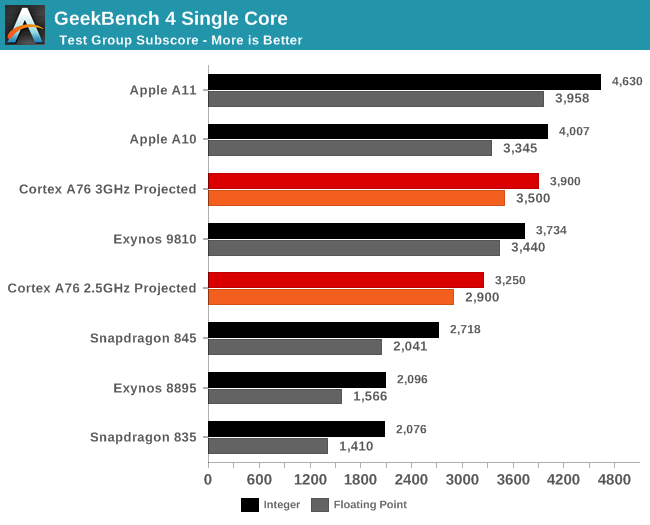
What this means in terms of absolute numbers is projected in the above graph. Baselining on the performance of the Snapdragon 835 and Snapdragon 845 a future SoC with an A76, 512KB L2’s and 2MB L3 would fall in around the GeekBench4 performance of the Exynos 9810 depending if the target 3GHz is reached.
In the past Arm has been overly optimistic when releasing frequency targets – for example the A73 was first projected at up to 2.8GHz and the Cortex A75 projected at up to 3GHz. In the end both ended up at no higher than 2.45GHz and 2.8GHz.
I’ve talked to a vendor about this and it seems Arm doesn’t take into consideration all corners when doing timing signoff, and in particular vendors have to take into consideration process variations which result in differently binned units, some of which might not reach the target frequencies. As mobile chips generally aren’t performance binned but rather power binned, vendors need to lower the target clock to get sufficient volume for commercialisation which results in slightly reduced clocks compared to what Arm usually talks about.
For the first A76 implementations in mobile devices I’m adamant that we won’t be seeing 3GHz SKUs but rather frequencies around 2.5GHz. Arm is still confident that we’ll see 3GHz SoCs but I’m going to be rather on the conservative side and be talking about 2.5GHz and 3GHz projections alongside each other, with the latter more of a projection of future higher TDP platforms.
Arm also had a slide demonstrating absolute peak performance at frequencies of 3.3GHz. The important thing to note here was that this scenario exceeded 5W and the performance would be reduced to get under that TDP target. It wasn’t clear if this was SoC power or solely CPU power – I’ll follow up with a clarification after I reach out to Arm.
Obviously the most important metric here alongside the performance improvements is the power and efficiency targets. In target products comparing Cortex A75 on a 10nm process versus a Cortex A76 on a 7nm process under the same 750mW/core power budget, the Cortex A76 delivers 40% more performance.
In terms of energy efficiency, a 7nm A76 at a performance target of 20 SPECint2006 of an A75 on 10nm (meaning maximum performance at 2.8GHz) is said to use half the amount of energy.
What is important in all these metrics again is that we weren’t presented an ISO-process comparison or a comparison at maximum performance of the A76 at 3GHz, so we’re left with quite a bit of guesswork in terms of projecting the end energy efficiency difference in products. TSMC promises a 40% drop in power versus 10FF. We haven’t seen an A75 implemented on a TSMC process to date so the best baseline we have is Qualcomm’s Snapdragon 845 on Samsung 10LPP which should slightly outperform 10FF.
Going through my projected data on one side we have performance on the right side: I baselined the SPECspeed scores on the average of the Snapdragon 835 and Kirin 970 measured results and applied Arm’s projected IPC claims and scaled the scores for frequency. For the 3GHz A76 projection this gets us the near 2x performance improvements in SPECint2006 vs the A73 generation of cores.
In terms of power efficiency, there’s more guesswork as the only real figure we have is as earlier stated the process scaled efficiency figures. Arm quoted a performance target of 20 SPECint2006 which I suspect is a 2.8GHz A75 run with GCC compiled benchmark binaries which have an advantage over my LLVM figures. If Arm wanted to compare against the Snapdragon 845 this matches roughly a 2.4GHz A76. Accounting for the process power improvement this roughly leaves a ~15% microarchitectural advantage for the A76. However as the A76 is targeted to perform 35% higher, and as we’ve seen in the past performance increases through clock don’t scale linearly with power, the power and efficiency advantages would very quickly degrade at peak performance.
Taking all factor into account as best as I could, we should be seeing 7nm A76 based SoCs beat slightly beat the energy efficiency of current Arm SoCs in terms of absolute energy usage at peak performance, a metric which is important as it is directly proportional to a device’s battery life. At a more conservative 2.5GHz clock this energy efficiency advantage would be greater and around 30% less energy than current generation A73 and A75 SoCs.
So on one hand the A76 would be extremely energy efficient, but also it could very well be a thermally constrained design as its peak performance we’d be seeing quite higher TDP figures. Arm states that the A76 is meant to run at full frequency in quad-core mode, however that claim is limited to larger form-factors, as for mobile devices, based on what I’m hearing vendors, will need to tone it down to lower clocks in order to fit smartphone designs.
Again the projection here contain a lot of variables and I’m erring towards the more conservative side in terms of performance and efficiency- however it’s clear that the jump will be significant in whichever way vendors will decide to push the A76 in (Performance or efficiency).


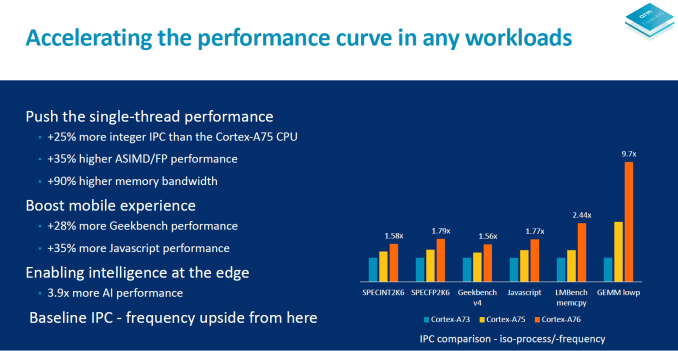

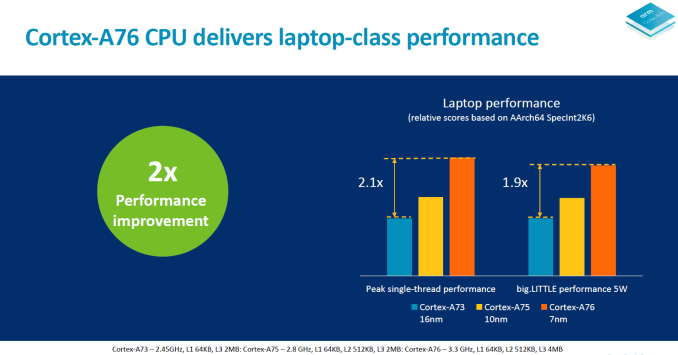
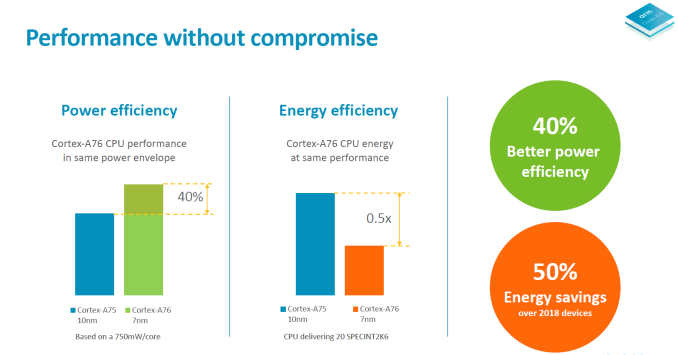
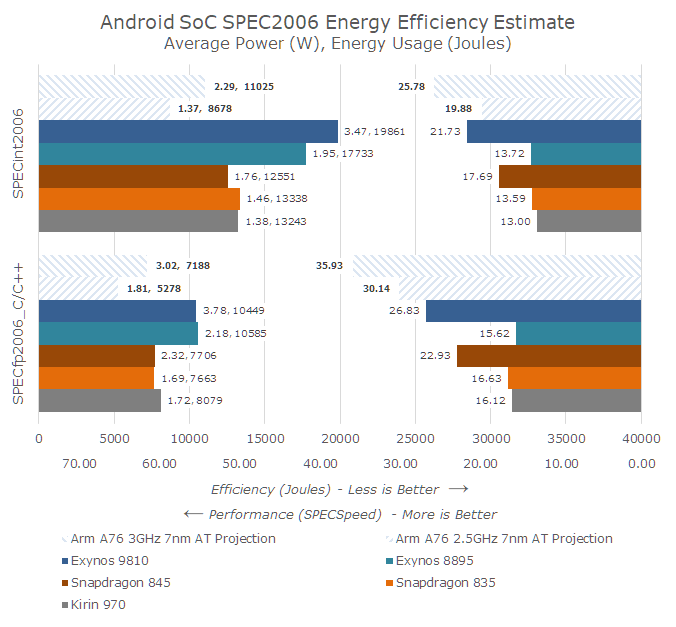














123 Comments
View All Comments
serendip - Thursday, May 31, 2018 - link
Does anyone actually use the full performance of the A11 or A12 in daily tasks? To me, it's pointless to have a power hungry and fast core just for benchmarks. Just make a slightly slower core with less power usage for quick bursts like app loading or Web page rendering, while much slower and more efficient cores handle the usual workload.jOHEI - Thursday, May 31, 2018 - link
ARM's objectives is to make CPU's that go into a cluster of 4+ another 4 small ones.What Apple has does is Making bigger cores >2 times the size of an ARM core and have 1.5x the performance of the Said core. That same CPU is made for very high Power consumption at maximum load and Apple tweaks the ammount of time it stays in those high clocks. Thus its easier to make a laptop chip-tablet and phone. Because you just reuse the same CPU for all of them, maybe add a few cores to the laptop version and tweak the power settings and its relatively easy.
jOHEI - Thursday, May 31, 2018 - link
Forgot to mention that Apple goes for 2 core clusters, not 4. So they must have significantly better single core performance to matchup against the Conpetition.name99 - Friday, June 1, 2018 - link
Just to correct that you are somewhat living in the past with your numbers.ARM no longer cares about 4-sized clusters; that was an artifact of big.LITTLE (and one of the constraints that limited that architecture's performance). The successor to big.LITTLE, brand-named dynamIQ, does not do things in blocks of 4 anymore.
Likewise Apple first released 3 CPUs in a SoC with the A8X. The A10X likewise has three CPUs. It's entirely likely (though no-one knows for sure) that the A11X (or A12X if the 11X is skipped) will have 4 large cores.
BurntMyBacon - Friday, June 1, 2018 - link
Due to ARM's licensing model, they have every incentive to push designs that cater to more cores. They have little incentive to push single threaded performance any more than necessary as this would result in few cores being licensed due to space and power constraints. I'm not fully convinced that the whole big.LITTLE (and derivative) philosophy was the best way to go either. It could be that it got close enough to what advanced power management could do with the benefit of providing a convincing case for ARM CPU designers to use double the cores or more. When Intel was still in the market, they demonstrated that a dual core chip with clock gating, power gating, power monitoring, dynamic voltage and frequency scaling, and other advanced power management features could provide superior single thread performance and comparable multithread performance in a similar power envelop to competing ARM designs with double the cores (all while burdened with the inefficient x86 decoder). Apple also had good success employing a similar philosophy until their A10 design. Though, it is not necessarily causal, it is interesting to note that they've had more trouble keeping within their thermal and power constraints on their latest A11 big.LITTLE design.Note: I don't have any issue with asymmetric / heterogeneous CPUs. I'm just not convinced that they are adequate replacements for good power management built into the cores. DynamIQ does seem to be a push in the right direction allowing simultaneous usage of all cores, providing hooks for accelerators, and providing fine grained dynamic voltage and frequency scaling. This makes a lot of sense when you can assign tasks to processors (or accelerators) with significantly better proficiency for the task in question. Switching processors for no other reason than it is lower power, however, just sounds like the design team had no incentive to further optimize their power management on the high performance core.
name99 - Friday, June 1, 2018 - link
Again a correction.Apple's problems with the A10 and A11 are NOT problems of power management; they are problems of CURRENT DRAW. Power management on the chips works just fine (and better than ever; high performance throttling tends to occur less with each successive generation, and it used to be possible to force reboot an iPhone if you got it hot enough, now that seems impossible because of better power management).
Current draw, on the other hand, is not something the SoCs were designed to track. And so when an aging battery is no longer able to provide max current draw (when everything on the SoC is lined up just wrong) then not enough current IS provided, and the system reboots.
This is definitely a flaw in the phone as a whole, but it's a system-wide flaw, and you can imagine how it happened. The SoC was designed assuming a certain current drive because no-one thought about aging batteries, because no-one (in Apple or outside) had hit the problem before.
I expect the A12 will have the same PMU that, today, monitors temperatures everywhere to make sure they remain within bounds, ALSO tracking a variety of proxies for current draw, and will be capable of throttling performance gradually in the face of extreme current draw, just like performance is throttled gradually in the face of extreme temperature.
eastcoast_pete - Friday, June 1, 2018 - link
Different design and use philosophies. Apple's mobile chips are designed to be able to deliver short bursts of very high processing power (opening a complex webpage, switching between apps), and throttle back to Okay fast during the remainder. That requires apps and OS to be tightly controlled and behave really well - one bad app that doesn't behave and keeps driving the CPU hard for longer periods and your phone would get hot (thermal throttling) , plus your battery would run down in a jiffy. For ARM & Co on Android/Linux, it makes more sense to have smaller, less powerful cores, manage energy consumption through other means (BigLittle etc), and increase performance by increading the number of cores/threads. Basically, if you really want to upscale the performance of stock ARM designs for a laptop or similar, you could dump the "little" cores and go for an octacore or decacore BIG, so all A76 cores. Might be interesting if somebody tries it.serendip - Friday, June 1, 2018 - link
It's not so simple - small A55 cores seem to work better in a quad or hexacore config, whereas A75s are best left in a dual core config at most because their perf/watt is poor. No point having a phone that's crazy fast but overheats and runs out of battery quickly.Apple's use of powerful but power-hungry cores could also affect the longevity of older phones. Older batteries might not be able to supply enough power for a big core running at full speed.
BurntMyBacon - Friday, June 1, 2018 - link
The fact that Apple is able to use an even larger and more power hungry core and a (marginally?) smaller battery should tell you that it is doable. Though, you are correct in saying it's not simple. The fact of the matter is, Apple has implemented much better power management features than ARM to allow for their cores to run at higher peak loads while needed and then being able to throttle down to lower power draw very quickly. ARM simply didn't design the A75 to do low power processing. The A75 is designed to rely on the A55 for low power processing as this provides an incentive to sell more core licenses.BillBear - Friday, June 1, 2018 - link
Traditionally, Apple builds a big ass core and clocks it low.It wasn't until FinFET made it to mobile chips that they started clocking higher.
>Apple has always played it conservative with clockspeeds in their CPU designs – favoring wide CPUs that don’t need to (or don’t like to) clock higher – so an increase like this is a notable event given the power costs that traditionally come with higher clockspeeds. Based on the underlying manufacturing technology this looks like Apple is cashing in their FinFET dividend, taking advantage of the reduction in operating voltages in order to ratchet up the CPU frequency. This makes a great deal of sense for Apple (architectural improvements only get harder), but at the same time given that Apple is reaching the far edge of the performance curve I suspect this may be the last time we see a 25%+ clockspeed increase in a single generation with an Apple SoC.
https://www.anandtech.com/show/9686/the-apple-ipho...
Qualcomm has been building small cores and vendors have been clocking them (with corresponding voltage increases) high.
Remember all the Android vendors getting caught red handed changing clockspeeds when they detected benchmarks running?